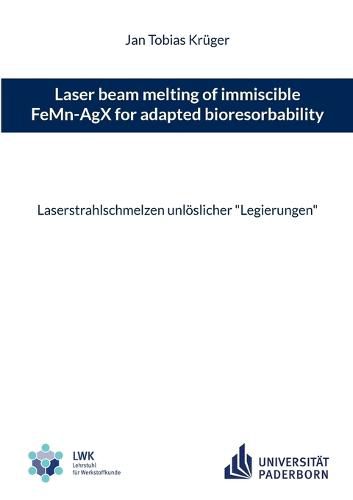Readings Newsletter
Become a Readings Member to make your shopping experience even easier.
Sign in or sign up for free!
You’re not far away from qualifying for FREE standard shipping within Australia
You’ve qualified for FREE standard shipping within Australia
The cart is loading…






This title is printed to order. This book may have been self-published. If so, we cannot guarantee the quality of the content. In the main most books will have gone through the editing process however some may not. We therefore suggest that you be aware of this before ordering this book. If in doubt check either the author or publisher’s details as we are unable to accept any returns unless they are faulty. Please contact us if you have any questions.
The application of Iron to open up new applications for bioresorbable implants is promising. However, modification of Iron is necessary to adjust the required properties. Alloying with Manganese improves the mechanical performance and increases the degradation rate. Further acceleration of degradation can be adjusting electrochemically noble phases to force the anodic dissolution of the Iron-based matrix. Since Silver and Iron are insoluble in each other, Silver phases can exist in an unmodified Iron-Manganese matrix. Silver is biocompatible and provides an antibacterial effect. If a degradable Silver alloy is used, the Silver phases can degrade after the Iron-Manganese matrix. One way to process metals that are not soluble in each other by melting metallurgy is powder-bed-based selective laser beam melting. The small melt pool, strong melt flow, and rapid solidification enable the inclusion of Silver in the Iron-Manganese matrix. To enable selective tailoring of the morphology, distribution, and chemical composition of the Silver phases, a model was developed for the interaction of the insoluble components in the melt pool and the formation of the Silver phases during laser beam melting. The principle effectiveness of anodic dissolution by Silver phases has been confirmed. However, this does not result in an increased degradation rate, since deposits with a blocking effect are formed.
$9.00 standard shipping within Australia
FREE standard shipping within Australia for orders over $100.00
Express & International shipping calculated at checkout
This title is printed to order. This book may have been self-published. If so, we cannot guarantee the quality of the content. In the main most books will have gone through the editing process however some may not. We therefore suggest that you be aware of this before ordering this book. If in doubt check either the author or publisher’s details as we are unable to accept any returns unless they are faulty. Please contact us if you have any questions.
The application of Iron to open up new applications for bioresorbable implants is promising. However, modification of Iron is necessary to adjust the required properties. Alloying with Manganese improves the mechanical performance and increases the degradation rate. Further acceleration of degradation can be adjusting electrochemically noble phases to force the anodic dissolution of the Iron-based matrix. Since Silver and Iron are insoluble in each other, Silver phases can exist in an unmodified Iron-Manganese matrix. Silver is biocompatible and provides an antibacterial effect. If a degradable Silver alloy is used, the Silver phases can degrade after the Iron-Manganese matrix. One way to process metals that are not soluble in each other by melting metallurgy is powder-bed-based selective laser beam melting. The small melt pool, strong melt flow, and rapid solidification enable the inclusion of Silver in the Iron-Manganese matrix. To enable selective tailoring of the morphology, distribution, and chemical composition of the Silver phases, a model was developed for the interaction of the insoluble components in the melt pool and the formation of the Silver phases during laser beam melting. The principle effectiveness of anodic dissolution by Silver phases has been confirmed. However, this does not result in an increased degradation rate, since deposits with a blocking effect are formed.